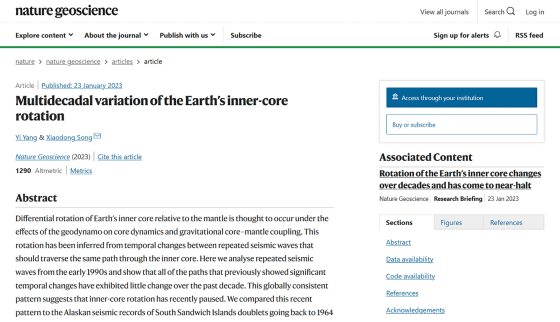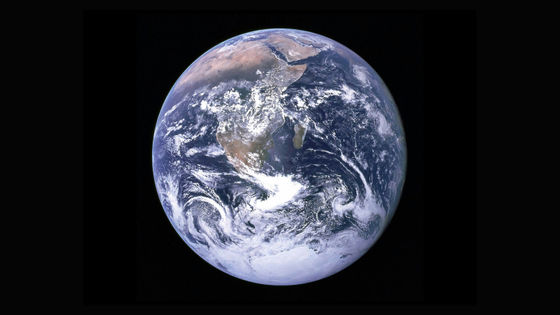Researchers report that 'strange rotation' occurring in the inner core of the earth has stopped

The Earth has a
Multidecadal variation of the Earth's inner-core rotation | Nature Geoscience
https://doi.org/10.1038/s41561-022-01112-z

Has Earth's inner core stopped its strange spin?
https://doi.org/10.1038/d41586-023-00167-1
Earth's Inner Core May Right Now Be in The Process of Changing Direction : ScienceAlert
https://www.sciencealert.com/earths-inner-core-may-right-now-be-in-the-process-of-changing-direction
Inge Lehmann , a Danish seismologist, discovered in 1936 that the propagation velocity of seismic waves inside the earth changes rapidly around 5100 km, and that the earth's core is divided into two layers, the outer core and the inner core. I figured out that I was divided. The Earth's most central inner core is about the size of the Moon, is composed of 96% solid iron under extremely high pressure, and can reach a temperature of over 6000 degrees Celsius, comparable to the surface temperature of the Sun. is known.
In 1996, Xiaodong Song, then a researcher at the University of Illinois, and Paul Richards at Columbia University published a paper stating, ``The inner core of the Earth rotates faster than the mantle.'' The results of this research are based on the analysis of data from the 1960s on changes in the time it takes for seismic waves generated in a specific region to reach observation points thousands of kilometers away. Song et al. discovered that the travel time of seismic waves changed from the 1960s to the 1990s.
Subsequent research showed that the inner core rotates about 1/10 of a degree faster than the mantle per 360 degrees around the Earth. I do not agree with the theory that Other studies suggest that the rotation of the inner core is transient rather than constant, and that there is no high-speed inner core rotation, and that seismic changes are caused by physical changes on the surface of the inner core. A paper has also been published that suggests that
Also, in a paper published in 2022, data from seismic waves generated by US nuclear tests from 1969 to 1971 showed that the Earth's inner core was 'rotating counterclockwise' during this period, or rotating more slowly than the mantle. was reported to have been The paper claims that the rotation speed of the inner core began to increase after 1971.

And Mr. Song, who became a professor of geophysics at Peking University, and Mr. Yi Yang, a researcher, analyzed seismic wave data observed from 1995 to 2021 and found that from around 2009, the travel time of seismic waves I discovered that the change was gone.
The fact that the travel time of seismic waves no longer changes suggests that the inner core no longer rotates at a high speed relative to the mantle, but instead rotates at the same speed. Since similar results have been observed at various points on Earth, Song et al. argue that this is a planet-wide phenomenon and not a local change in the inner core surface.
The data suggest that the rotation speed of the inner core has slowed down, and that it may be in the process of counter-rotating. Song et al., ``These are surprising observations suggesting that the inner core's rotation has nearly stopped over the last decade, and may be undergoing a multi-decadal cycle at a turning point since the early 1970s. 'He argued that the rotation of the inner core may be related to changes in the length of the day and the magnetic field, which has a periodicity of about 70 years.

Related Posts:
in Science, Posted by log1h_ik







